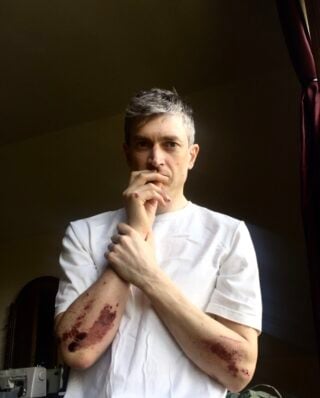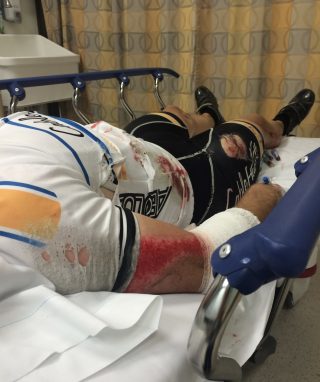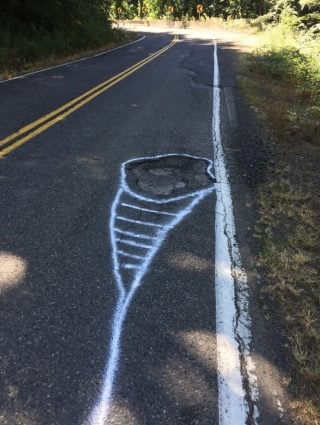
(Written by Scott Kocher, a Portland-based pedestrian and bicycle lawyer at Forum Law Group LLC and safe streets advocate advocate. We recently highlighted his efforts to improve Highway 30. Note: Kocher’s law firm is also a financial contributor to BikePortland, but that had no influence on editorial decisions.)
I love to ride in the West Hills. From the central city, they’re the closest place to escape stop-and-go traffic. On weekends, people enjoying Northwest Skyline on bikes seem to outnumber people in cars. On weekdays, commuters zip between Portland and the west side. It feels like a world apart from Highway 26 gridlock.
Which brings me to March 16th. I was riding down NW Cornell from Skyline. There were bad potholes below the upper tunnel. Not just bumps, these were the kind that could easily cause a person on a bicycle to crash — which could be catastrophic at downhill speeds. Hoping to get them filled, I stopped and reported the potholes using the City of Portland’s PDX Reporter web app.
I noted in the report that the holes were a hazard for people on bikes. On March 28th, those potholes weren’t fixed, so I reported them again. On May 1st, I took a day off to go check on the route of a popular group bike ride that typically draws 100s of people. The potholes on Cornell were still there. I marked them with yellow paint, and reported them, for the third time.

Half an hour later, I was descending West Burnside from Skyline. It’s a long, wide road with fast traffic. Most cyclists ride with the flow of other traffic and take the lane. It’s nobody’s favorite route, but it’s the most direct route to downtown, and the asphalt is in good shape. Except about half way down, at Arboretum Circle, where, unbeknownst to me, a water main had broken and been repaired. A spot next to the asphalt repair wasn’t fully compacted. I hit the sunken spot at traffic speed. My bike stopped, and I kept going. I tumbled and slid 145 feet.
“He wanted to know if I had finally come to fix the sunken spot, because it made his house shake when trucks hit it, and he’d reported it. Three times.”
After getting checked out and my wounds cleaned at Good Sam, I reported the sunken spot that crashed me. Two days later, I was able to get up there with spray paint. As I was marking the spot so that the City crew could be sure to find it, a neighbor, Bill, saw me in my yellow vest and came out. He asked if I was from the City. He wanted to know if I had finally come to fix the sunken spot, because it made his house shake when trucks hit it, and he’d reported it. Three times.
This wasn’t the first or the second time PBOT didn’t do its job. In May and again in June 2014 I used the PDX Reporter app to report potholes and cracks in the downhill lane of NW Cornell up toward NW 53rd Ave that were “bad enough catch the wheel of a bicycle and cause a fall.” The next month, in July, my friend and riding buddy Richard Lorenz crashed on them.
Advertisement

Even worse, in 2017, I reported a wretched pothole on NW Thompson. It was multiple layers deep, large, and very hard to see in the leafy shadows. A car driver could have crashed from it. I reported it, noting it was a hazard for bikes – something I don’t do lightly. Nobody fixed it. I heard later that a person on a bicycle crashed on it, and had to have brain surgery. After that, I went back up with a can of paint. It still wasn’t fixed.

The concern isn’t limited to the West Hills. After my crash, more people have told me their experiences. One stood out. Unable to cut my own hair, I went to the barber shop. Jessica, who cut my hair much better than I do, told me she used to bike, and loved to commute — all the way from outer southeast to the Slabtown Barbershop in northwest. But she stopped biking after she crashed on a pothole in Woodstock:
“Two years ago I was bike commuting and my tire hit the wrong angle on one of the cracks in the road and I was flipped over my handle bars,” she shared with me. “I reported the incident, but it hasn’t been filled.”
In 2010 OHSU researchers released a study of nearly 1,000 Portlanders who commuted on bicycles for a year. They found, “poor roadway surface conditions” were a factor in 21% of traumatic crashes and 20% of “serious traumatic” crashes.
Here’s what we should do about this
Speed up dangerous pothole fixes. It costs roughly the same whether the crew goes the next day or the next month. Doing that would have saved my injuries, and could save a life. This isn’t just for people on bicycles. E-scooters have much smaller wheels. People on motorcycles and mopeds are also vulnerable to potholes and other asphalt defects.
Get pothole crashes onto the Vision Zero Crash Map. All four of the crashes I’ve described count as “bicycle serious injury” crashes. Yet they are not officially counted. Why? Because like crashes on streetcar tracks, most roadway defect crashes don’t involve an automobile user. Therefore, none of them generate a police report, make it into ODOT’s dataset, or get onto the Vision Zero Crash Map.
Create a user-generated reporting tool. Let’s get these on a map. Too many crashes and injuries go unnoticed. The public has demanded this for years: From BikePortland’s B-SMART tool (now defunct) and Nathan Hinkle’s NearlyKilled.me website to the streetcar track efforts of Active Right of Way (also now offline). It’s not right that individuals and activists have to spearhead these efforts. The proper way to do this would be for the City of Portland to provide a web form for people to report and upload crashes directly onto the Vision Zero map themselves.
If we don’t measure it, we won’t improve it.
We gave PBOT an opportunity to respond to questions and will update this story when we hear back. If you see a dangerous pothole, please report it to PBOT via the PDX Reporter app, 503-823-1700, or by emailing pdxroads@portlandoregon.gov.
— Scott Kocher, @scott_kocher
Never miss a story. Sign-up for the daily BP Headlines email.
BikePortland needs your support.

